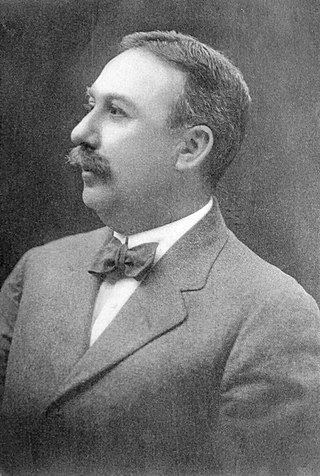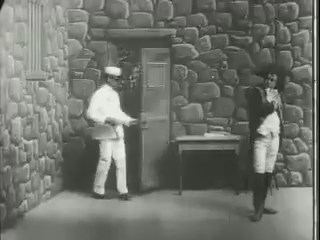Related Research Articles

The Great Train Robbery is a 1903 American silent film made by Edwin S. Porter for the Edison Manufacturing Company. It follows a gang of outlaws who hold up and rob a steam locomotive at a station in the American West, flee across mountainous terrain, and are finally defeated by a posse of locals. The short film draws on many sources, including a robust existing tradition of Western films, recent European innovations in film technique, the play of the same name by Scott Marble, the popularity of train-themed films, and possibly real-life incidents involving outlaws such as Butch Cassidy.
The year 1903 in film involved many significant events in cinema.
The following is an overview of the events of 1898 in film, including a list of films released and notable births. The Spanish–American War was a popular subject. Several films made by Col. William N. Selig dealt with the subject of war preparations at Camp Tanner in Springfield, Illinois, including Soldiers at Play, Wash Day in Camp and First Regiment Marching.

The Dickson Experimental Sound Film is a film made by William Dickson in late 1894 or early 1895. It is the first known film with live-recorded sound and appears to be the first motion picture made for the Kinetophone, the proto-sound-film system developed by Dickson and Thomas Edison. The film was produced at the "Black Maria", Edison's New Jersey film studio. There is no evidence that it was ever exhibited in its original format.

Edwin Stanton Porter was an American film pioneer, most famous as a producer, director, studio manager and cinematographer with the Edison Manufacturing Company and the Famous Players Film Company. Of over 250 films created by Porter, his most important include What Happened on Twenty-third Street, New York City (1901), Jack and the Beanstalk (1902), Life of an American Fireman (1903), The Great Train Robbery (1903), The European Rest Cure (1904), The Kleptomaniac (1905), Life of a Cowboy (1906), Rescued from an Eagle's Nest (1908), and The Prisoner of Zenda (1913).

Life of an American Fireman is a short, silent film Edwin S. Porter made for the Edison Manufacturing Company. It was shot late in 1902 and distributed early in 1903. One of the earliest American narrative films, it depicts the rescue of a woman and child from a burning building. It bears notable similarities to the 1901 British short film Fire!, directed by James Williamson.

Maniac Chase is a 1904 American short silent comedy film directed by Edwin S. Porter and produced by the Edison Manufacturing Company. The film is a remake of The Escaped Lunatic, a film directed by Wallace McCutcheon Sr. released at the beginning of 1904. This was one of two Biograph Company hits remade by Edison's company in fall 1904, the other being Personal, which was copied as How a French Nobleman Got a Wife Through the New York Herald Personal Columns.

Terrible Teddy, the Grizzly King is a 1901 American silent film directed by Edwin S. Porter. Produced by the Edison Manufacturing Company, it is the earliest known political satire in American film. It features three actors, all of whom are unknown.
Wallace McCutcheon Sr. was a pioneer cinematographer and director in the early American motion picture industry, working with the American Mutoscope & Biograph, Edison and American Star Film companies. McCutcheon's wealth of credits are often mixed up with the small handful of films directed by his son, Wallace McCutcheon Jr. (1884–1928).

Execution of Czolgosz with Panorama of Auburn Prison is a 1901 silent film produced by the Edison Studios arms of Edison Manufacturing Company. The film is a dramatic reenactment of the execution of Leon Czolgosz by electric chair at Auburn Correctional Facility following his 1901 conviction for the assassination of William McKinley. It is considered an important film in the history of cinema.

Faust and Marguerite is a 1900 American silent trick film produced and distributed by Edison Manufacturing Company. It was directed by Edwin S. Porter and based on the Michel Carré play Faust et Marguerite and the 1859 opera Faust adapted from the play by Charles Gounod.
Parsifal is a 1904 American silent film produced by the Edison Manufacturing Company and directed by Edwin S. Porter. It is based on the 1882 opera Parsifal by Richard Wagner, and stars Adelaide Fitz-Allen as Kundry and Robert Whittier as Parsifal.

Dream of a Rarebit Fiend is a 1906 silent trick film directed by Edwin S. Porter for Edison Manufacturing Company. It is a seven-minute live-action film adaptation of the comic strip Dream of the Rarebit Fiend by American cartoonist Winsor McCay. The film was marketed as using several special effects in which "some of the photographic 'stunts' have never been seen or attempted before."

The Count of Monte Cristo is a 1913 silent film adventure directed by Joseph A. Golden and Edwin S. Porter based on Alexandre Dumas' 1844 novel of the same name. It starred James O'Neill, a stage actor and father of playwright Eugene O'Neill. James O'Neill had been playing Edmond Dantès most of his adult life and was famous in the role. Daniel Frohman and Adolph Zukor produced together. Edwin S. Porter co-directed with Joseph Golden, though this was probably necessary as Porter also served as the film's cinematographer. The film was released on November 1, 1913.

"Weary Willie" Kisses the Bride is a surviving 1904 silent comedy short film produced by Thomas Edison and directed by Edwin S. Porter and preserved from a paper print in the Library of Congress. The film was copyrighted as Nervy Nat Kisses the Bride, but sold as "Weary Willie". Another 1904 Porter short was released called "Weary Willie" Kidnaps a Child.

Uncle Josh at the Moving Picture Show is a 1902 American short silent comedy film directed by Edwin S. Porter, featuring a naive spectator trying to interact with films projected onto a screen. It is an almost identical remake of a British 1901 film directed by Robert W. Paul, The Countryman and the Cinematograph. Paul's film was the first to feature a film shown within a film.

The Whole Dam Family and the Dam Dog is a 1905 silent short comedy film directed by Edwin S. Porter for the Edison Manufacturing Company. The five-and-a-half minute film was an adaptation of a popular picture postcard featuring a humorously named family. The film introduces each member of the Dam family, and then shows a raucous dinner scene that ends with the Dam dog pulling the tablecloth off the table, and ruining the Dam meal.

How Jones Lost His Roll is a 1905 silent short comedy film directed by Edwin S. Porter. The movie was popular for its clever use of animated title cards — the first example of stop-motion animation in American film.

Laura Comstock's Bag-Punching Dog is a 1901 silent short film directed by Edwin S. Porter. The film depicts a vaudeville act featuring Laura Comstock and her trained dog, a pit bull named Mannie. Comstock's act was currently appearing at Keith's Union Square Theatre.

The Old Maid Having Her Picture Taken is a 1901 silent short film directed by Edwin S. Porter in collaboration with George S. Fleming. The comic film depicts an unattractive old woman arriving at a photo studio to have her picture taken, and destroying all of the equipment through the power of her ugliness.
References
- ↑ Vitagraph - Edison (December 1898), The Cavalier's Dream (1898) , retrieved 2018-03-04
- ↑ Musser, Charles (1991). Before the Nickelodeon: Edwin S. Porter and the Edison Manufacturing Company. University of California Press. pp. 511–512. Retrieved 1 February 2024.
- ↑ Niver, Kemp R. (1985). Early Motion Pictures: The Paper Print Collection in the Library of Congress. Washington, D.C.: Library of Congress. pp. 50–51. Retrieved 16 February 2024.
- ↑ The Cavalier's Dream (1898) , retrieved 2018-03-04
- ↑ "The Cavalier's Dream (1898)". Century Film Project. 2017-10-03. Retrieved 2018-03-04.